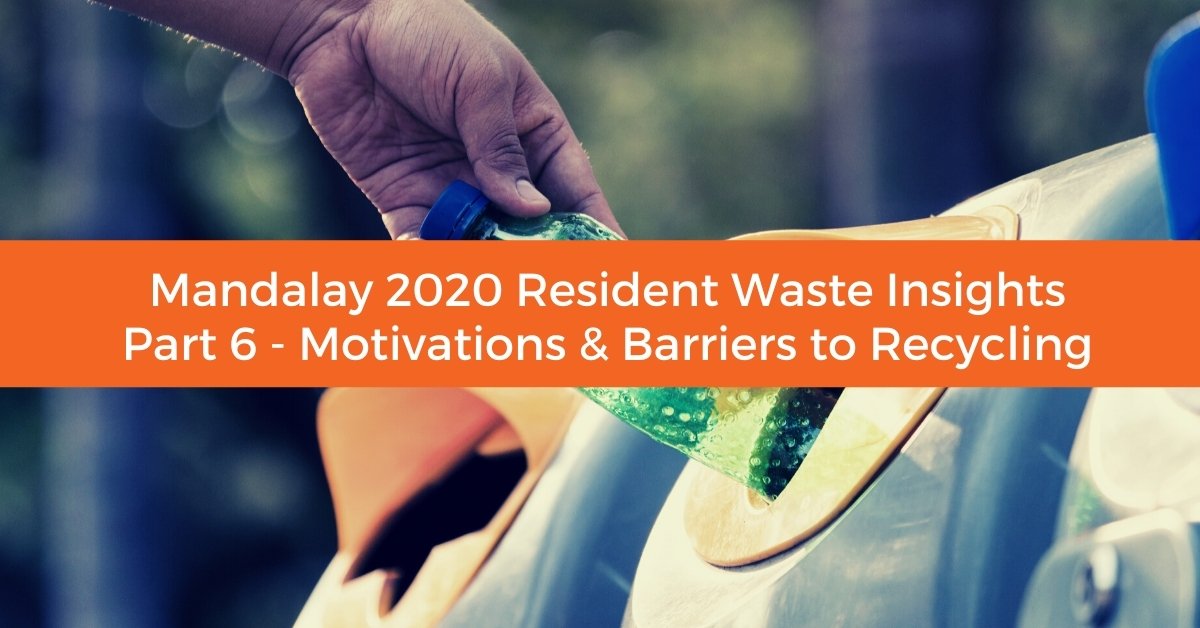
What are the Motivations and Barriers to Recycling for Australians?
We know that most people inherently want to do the right thing when it comes to recycling, yet as a nation we could be doing much better when it comes to recycling. To do better, we must first understand what motivates people to recycle and then what prevents them from recycling more effectively. Equally, understanding the sources of information people refer to, and are aware of, when it comes to recycling correctly is also worthwhile knowing and understanding. This is all important information that supports the journey towards more and better recycling that we explore below.
About the Research
Here at Mandalay, we have collaborated with Footprints Market Research to undertake online research with over 1,500 Australians. Our goal is to help local councils across Australia gain a better understanding of waste and recycling behaviours. A portion of the data within this report has been interpreted in this blog. For even more insights, download a copy of the full Mandalay 2020 Waste Report.
What does the data tell us?
Motivations to recycle
As part of the research, participants were given a series of options to choose from the primary motives for Australians to recycle. We found that there were two primary motivations for recycling – (i) environmental awareness and (ii) the reuse of materials.
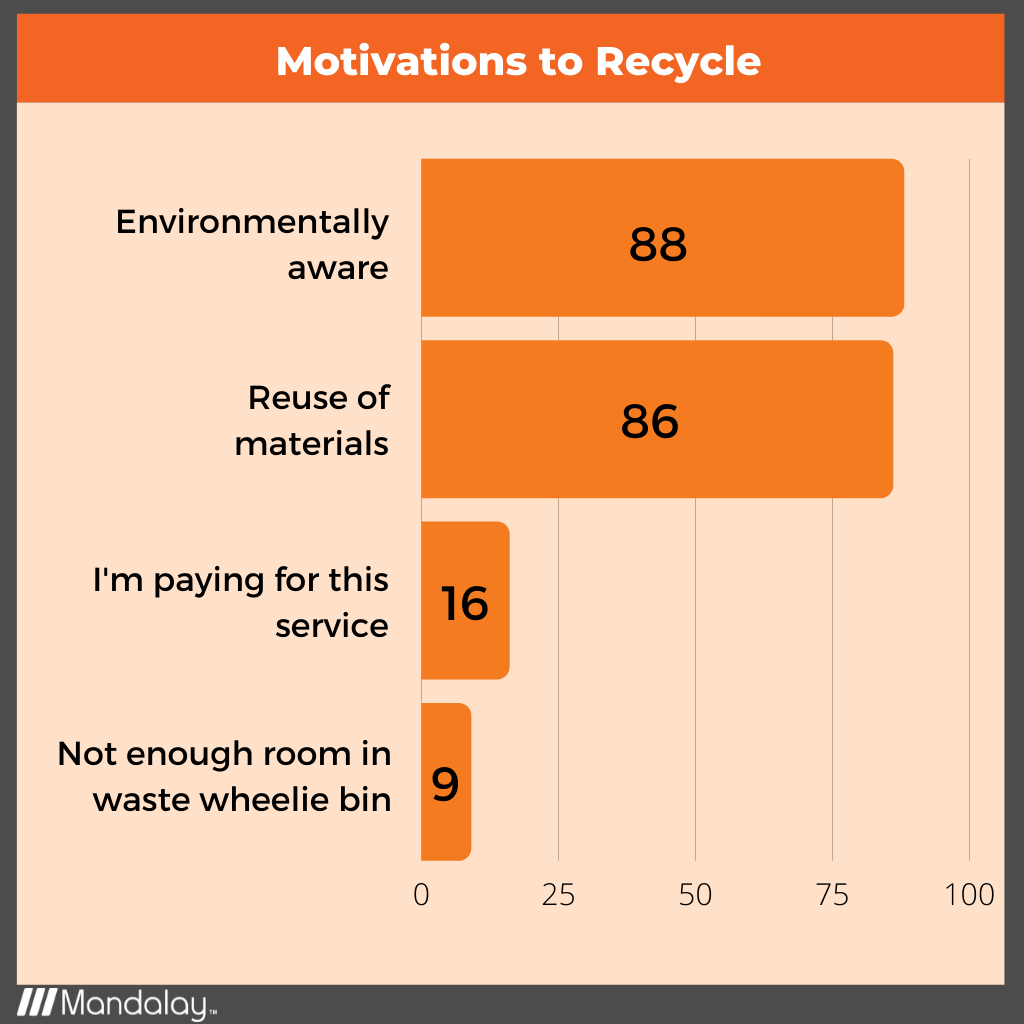
Motivations to recycle by location
Responses were mostly consistent across the board when broken down by location, with ‘environmentally aware’ being the reason for recycling across all states except for rural locations, where the reuse of materials was more prevalent as the reason for recycling. Notably, twice as many South Australians responded with ‘not enough room in the waste bin’ (12%) as a motivation compared to Victorians and Australians more broadly (6% each).

Motivations to recycle by age range
When this data is broken down by age range, we can see that younger residents are more likely to nominate ‘environmental awareness’ as a motivation for recycling while older residents nominate ‘reuse of materials’ as the primary motivation. The 70 plus age bracket was twice as likely to answer ‘paying for this service’ as the motivation for recycling (21%) compared to the 18-29 age bracket (12%).
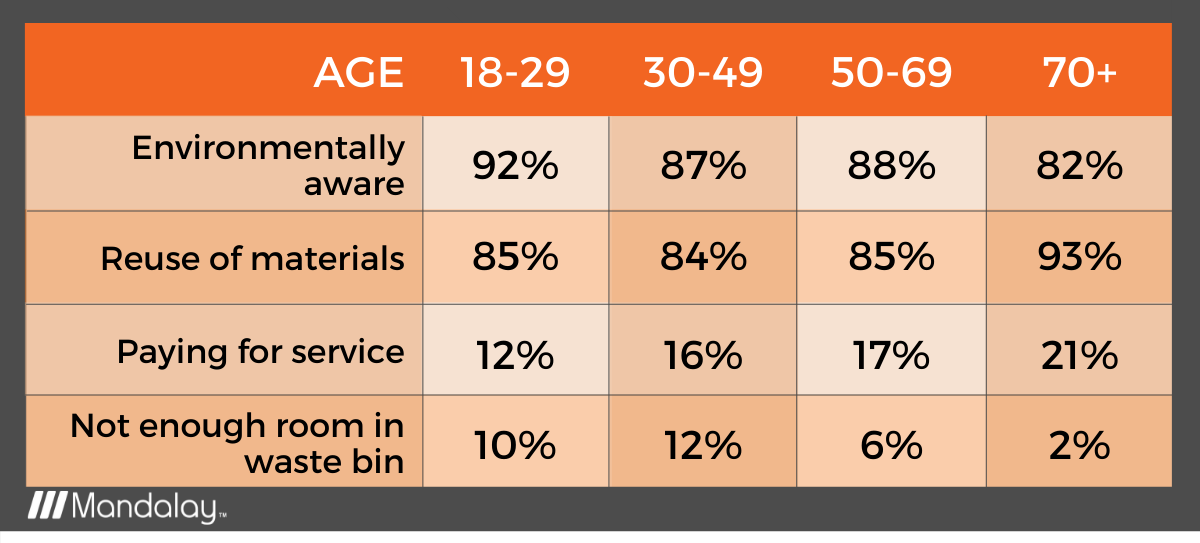
Barriers to recycling
Participants in this survey were asked about their primary barrier to recycling. While not included in Mandalay’s 2020 Waste Report, the original research identified that the most significant (self-reported) barrier to recycling is uncertainty if some materials can be recycled. Inconvenience is noted by almost one in five residents, while a similar number are cynical if recycling actually occurs.
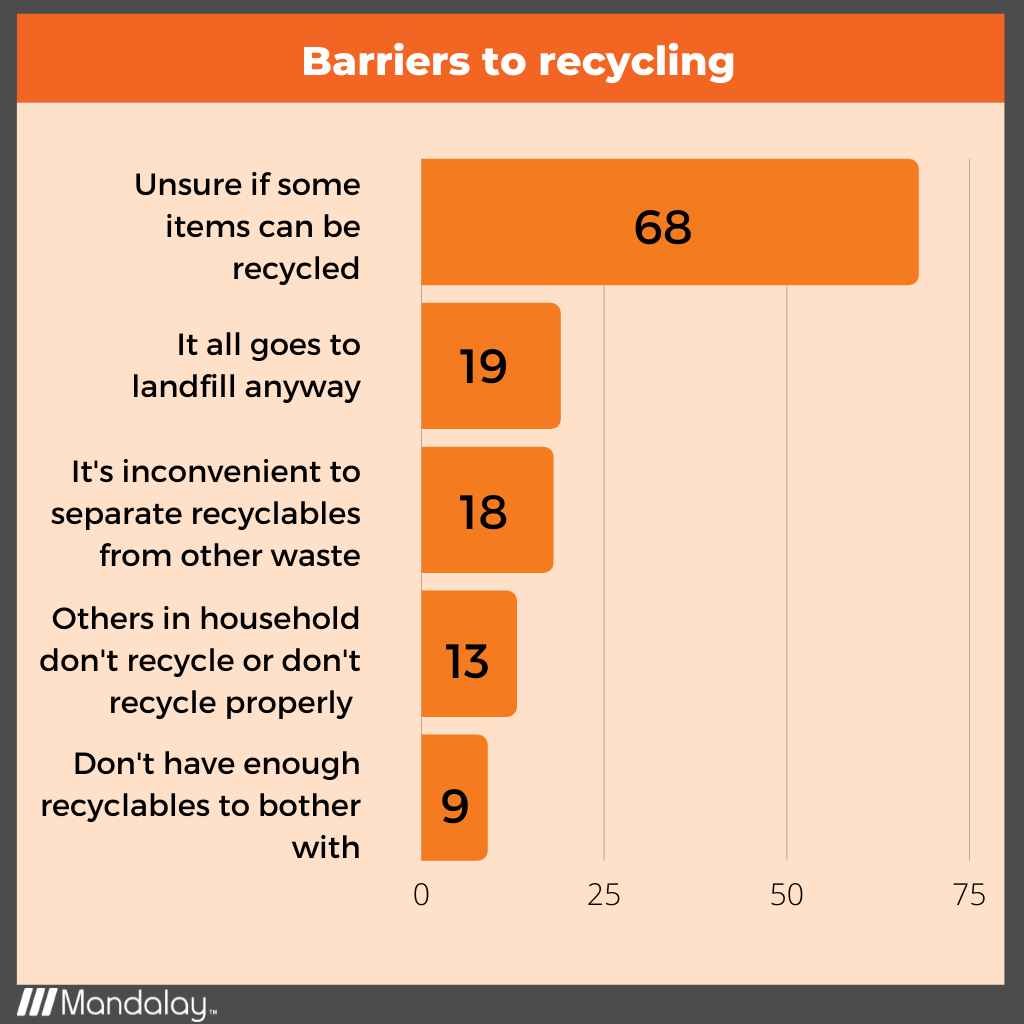
Barriers to recycling by location and demographics
Significant differences were found when this data was broken down into locations and demographics. The data below shows percentage figures that are higher than the national average.
- NSW residents were 22% more likely to note the inconvenience of separating recyclables from other waste as a barrier to recycling.
- 22% more Victorians responded with ‘it all goes to landfill anyway’ as a barrier to recycling.
- 20% more metro residents said it was inconvenient to separate recyclables from other waste compared to regional and rural residents.
- 23% more apartment residents said it was inconvenient to separate recyclables from other waste compared to residents in other dwelling types.
- Participants in the 18-29 age bracket were more likely to be unsure about what can be recycled (73%) and found it inconvenient to separate waste and recycling (20%)
- Participants in the 30-49 age bracket had a 20% higher response of ‘inconvenient to separate recyclables from other waste’ compared to the national average.
- Participants in the 70+ year olds had a 75% higher response of being unsure about what can be recycled compared to the national average.
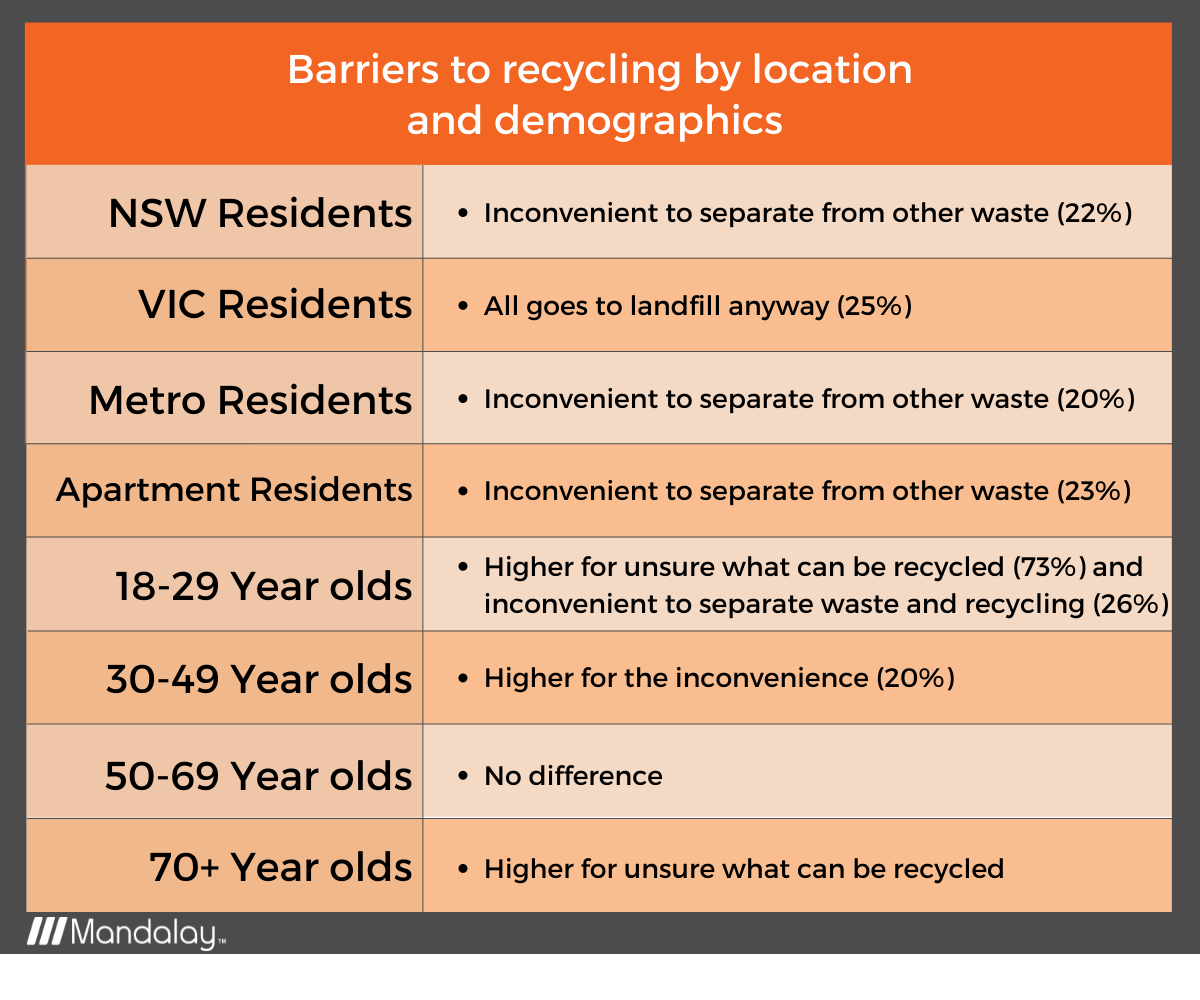
Recycling sources of information
Participants were also asked about the most effective sources of information they have experienced to support their recycling. Visual reminders at the point of waste disposal (e.g., stickers on the wheelie bin) were the strongest reminders to residents regarding what to recycle, as was word of mouth and information gleaned through the media. The least impactful sources of information were the radio and schools.
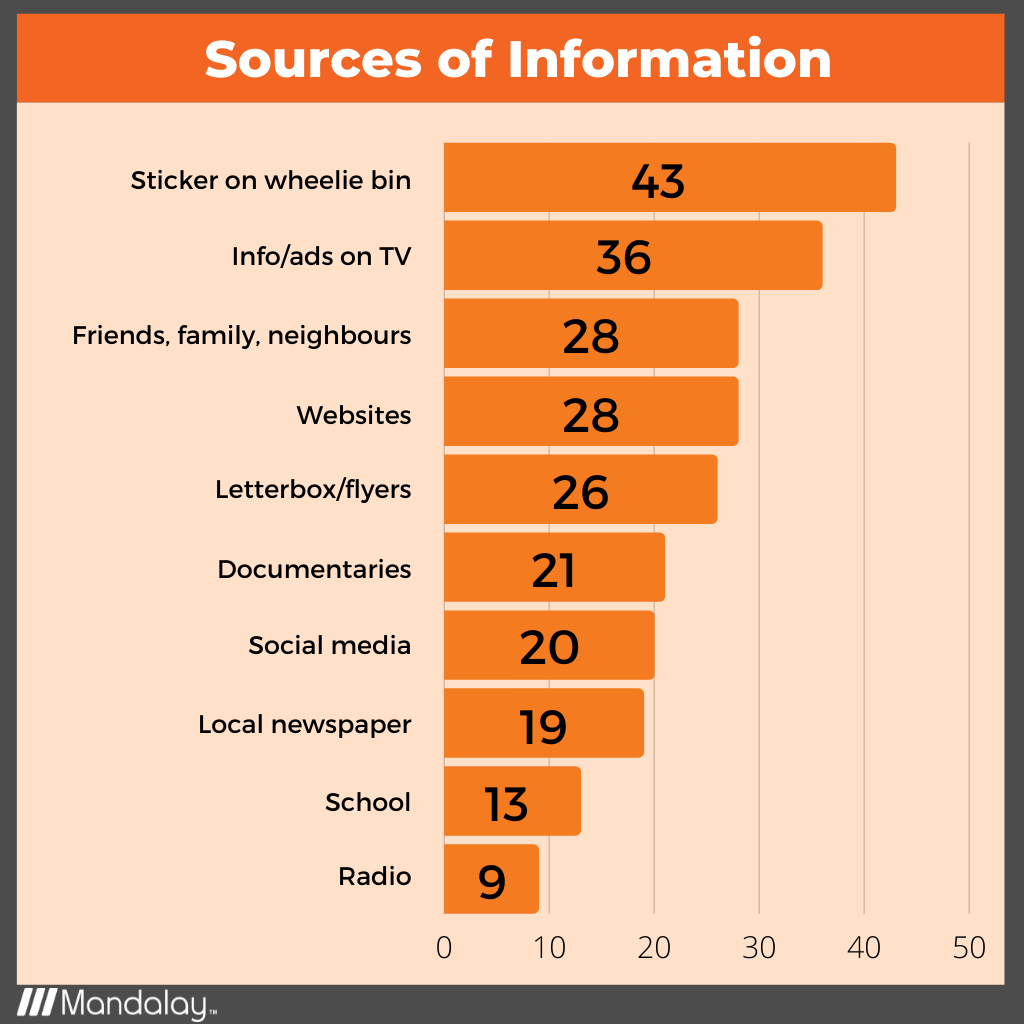
Recycling sources of information by location and age range
There are significant differences in how information is sourced for each location and age group.
- Word of mouth and social media were more influential for younger residents while wheelie bin stickers, flyers and local media were more important for older residents.
- Metro residents were more reliant on websites while rural residents were more likely to source their information from the local paper.
- NSW residents had a higher reliance on social media and radio compared to other states.
- Victoria relied more on letterbox flyers for their information while Queensland had a lower reliance on letterbox flyers compared to other information sources.
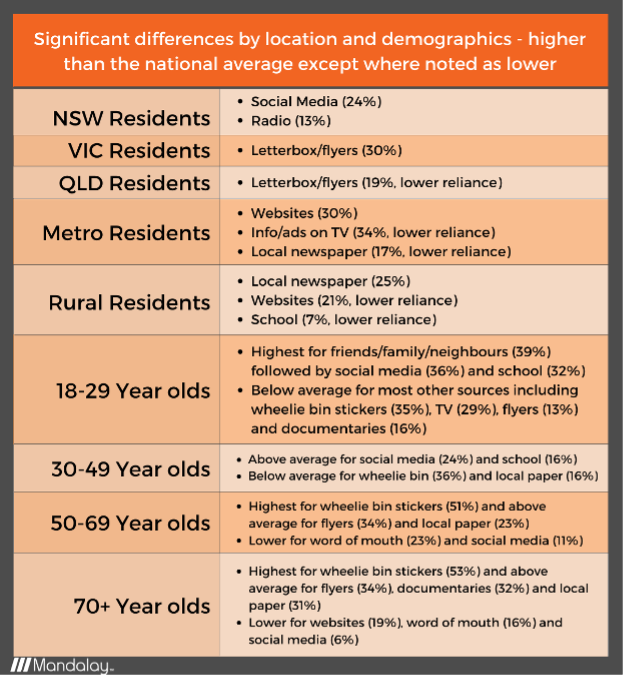
What Can We Learn from This Data?
By understanding what motivates people to recycle, local councils and private sector operators are better equipped to target education and communication campaigns that affect change (i.e., better recycling outcomes). The research includes many interesting insights into opportunities to inform and influence residents to recycle more and recycle better, including the type of mediums that are most effective in sharing the right information. It’s no surprise that younger age groups are more reliant on social media and online sources for information, while older populations are more reliant on traditional mediums like wheelie bin stickers, flyers, and the local paper. Nonetheless, it is always helpful to validate the most effective tools.
What’s more interesting is the data we have gleaned about the reported barriers to recycling. It is pertinent to note that some of the highest barriers to recycling are – (i) uncertainty about whether some items can be recycled; (ii) inconvenience to separate recycling from other waste; and (iii) cynicism regarding whether recycling actually occurs with the recycled materials. We can all attest to the fact that there is a lot of anecdotal grounding to this data as well as media reporting, particularly the cynicism around whether items are actually recycled. China’s ban on the importation of recycled materials, which has seen surplus recycled material disposed in landfill in Australia, has only exacerbated this cynicism.
Increasing awareness of the services available to residents, through targeted education and communication campaigns, is one of the ways to increase motivation and behaviour for better recycling outcomes. However, going beyond these standard tools and given the complexity of the waste and resource recovery industry, addressing barriers to recycling will require a multi-faceted and coordinated approach from all levels of government and all stakeholders. We have touched on some of these actionable measures in the past and, to re-cap, it would look a little something like this:
1. Using data to increase awareness around behaviour
Personalised data, both its collection and use, to increase awareness around behaviour is critical to shifting community attitudes. It has the potential to not only enable data driven analysis and decision making for local councils and private sector operators, but also support more empowered behaviour change for residents to incentivise better recycling outcomes. Utilising the power of technology to build more precise behaviour data will enable increasingly personalised services to residents and target segments within their communities.
2. Harmonisation of waste, recycling and resource recovery services
The harmonisation of waste, recycling and resource recovery services would go a long way to supporting residents to recycle more and recycle better. Putting in place the same services, with the same standards for waste collection and recycling, would be a major step for supporting residents on this journey and in reducing confusion around what to recycle and what not to recycle. There is a great deal of work happening in the space, but it will be a long journey that will require everyone involved to sustain the momentum.
3. Adopting behaviors that recognise the value of waste
Incentivising better outcomes when it comes to recycling and resource recovery also requires individuals to adopt behaviours that recognise the value of waste and the value of retaining that waste in the economy. There needs to be consistent national messaging about the importance of the move towards a circular economy so that we all make better choices about what we buy, how we use it and how we dispose of it – with the ultimate goal of not creating the waste in the first place so that, as a community, we can tackle global issues associated with the degradation of our environment.
4. Developing end markets for recycled products
Developing end markets for recycled products whereby current and future onshore manufacturers source raw materials from recycled items rather than virgin product will be key. This, and executed product stewardship schemes, are the key to keeping materials circulating through the economy. The success of developing markets for recycled materials will require – (i) identifying the right markets in the first instance; (ii) creating demand for those types of products; (iii) big investment from governments and industry alike; and (iv) managing consumer perceptions around the quality of products.
5. Giving certainty around where recycled materials go
Finally, giving certainty around where the recycled materials are going, what happens to them and transparency back to residents in how they are used would increase resident motivations to recycle more and recycle better. The lack of confidence in what’s being actually recycled has to be addressed.
Want access to even more statistics and insights on awareness and behaviours towards waste and recycling in Australia?
Download a free copy of Mandalay’s 2020 Waste Report here.
Read Part 5 within the Resident Waste Insights Series – Australia’s commitment to, knowledge of and behaviours towards recycling



